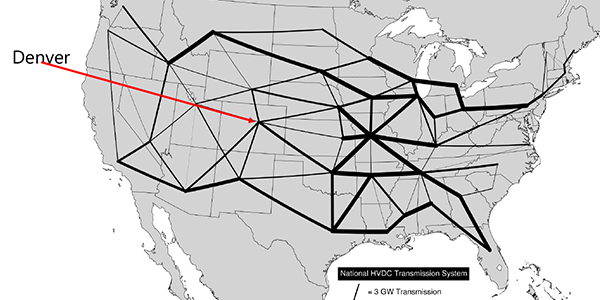With deadlines for Colorado’s steep decarbonization goals fast approaching, state officials are considering every avenue to decrease emissions.
While the path to 80% emissions reductions from 2005 levels by 2030 seems manageable, reaching net zero will be the bigger challenge, according to Colorado Public Utilities Commissioner John Gavan.
“When you talk to our utility executives, they say, ‘Well, we think we have a plan to get [to 80%], but when we look at going from 80 to 100, we have no idea how we’re going to do it,’” Gavan said during a Commissioner Information Meeting on Monday.
Interstate transmission “may very well be the secret sauce that allows us to get 100%,” he said.
Monday’s meeting brought together experts to share findings on possible interregional transmission models. Grid Strategies President Rob Gramlich started by noting that each regional grid operator has its own shortcomings, exemplified by deficiencies in MISO, SPP and ERCOT during February’s cold snap, and high prices during extreme weather events in the Northeast. To address these shortcomings, the U.S. will need large-scale interconnected transmission systems that enable substantial energy transfers between regions, he said.
“By allowing new transmission to interconnect larger areas, you get better access to higher quality resource regions and thus more energy from less installed PV/wind capacity,” MIT Energy Initiative’s Patrick Brown said, citing his study on the value of interregional transmission in decarbonizing the U.S. The study showed that reaching 100% decarbonization with today’s widely available technology — primarily onshore wind and solar — will be much more cost effective with interregional transmission planning.
Vibrant Clean Energy CEO Christopher Clack told the commission that the windiest regions of the U.S. are in the center of the country while the sunniest are in the East and West. A nationally interconnected transmission system running from east to west would allow carbon-free power to be transferred to where demand is highest, enabling utilities to participate in a variety of energy markets and enhancing grid resilience.
Circling back to the state level, Clack said Colorado will reach a 16-GW demand peak in both summer and winter by 2050. Because it would not be feasible for Colorado to build all the capacity necessary to meet future demand, the state must turn to interstate transmission.
“If we try to do it on our own as a state without interstate transmission, we’re going to get lumbered with high costs … or lose the commerce to other states,” he said.
In a nationally interconnected transmission system, Colorado could be a hub that facilitates energy transfers between regions and would benefit from its high wind and solar output, Clack said.
But commission Chairman Eric Blank said building a transmission system of that scale is no easy feat and seems unlikely without federal guidance. He asked what Colorado could do in the near term to enhance transmission.
A nationwide system is key to unlocking the full decarbonization potential of interregional transmission, Clack said, but interconnecting Colorado to its neighboring states (specifically Kansas, which falls in SPP’s footprint) in the short term would still help reduce emissions and enhance reliability.
SB21-072
While the PUC ponders the potential benefits of interstate transmission planning, a bill that would require that process is under review in the Colorado Senate. If passed, SB21-072 would require electric utilities that own transmission facilities to join an RTO in order to support the state’s decarbonization goals, though there may be exceptions.
“The commission may delay or waive this requirement for a utility that is unable, despite its best efforts, to find a viable and available RTO to join or if the commission finds … that requiring the utility to join an RTO would not be in the public interest,” the bill states.
Under the bill, the PUC would be responsible for approving new transmission projects and ensuring the “ability of the proposed facilities to support future expansion as needed to enable the utility to participate in a regional transmission organization.”
The legislation would also create the Colorado Electric Transmission Authority (CETA) to facilitate interstate transmission planning. CETA would “identify and establish intrastate electric transmission corridors; coordinate with other entities to establish interstate electric transmission corridors; [and] exercise the power of eminent domain to acquire eligible facilities.”




